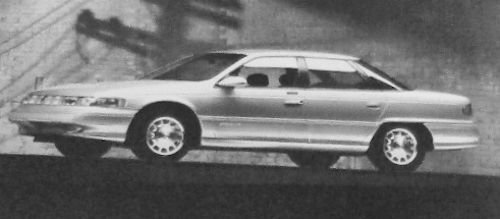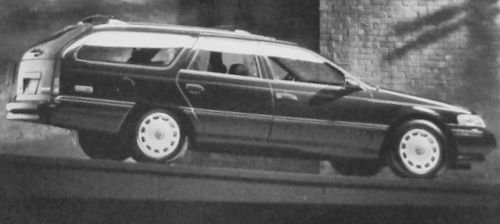Mercury Sable Second generation
 |
|
|
Production |
1991 to 1995 |
|
Assembly |
USA |
|
Designer |
Jack Telnack |
|
Body style |
4-door sedan ,station wagon |
|
Layout |
FF layout |
|
Platform |
Ford DN5 Platform |
|
Engine |
3.0 L Vulcan V6 |
|
Transmission |
4-speed AXOD-E/AX4S automatic |
|
Wheelbase |
106 in (2,692 mm) |
|
Length |
192.2 in (4,882 mm) (sedan) |
|
Width |
71.2 in (1,808 mm) |
|
Height |
54.4 in (1,382 mm) (sedan) |
The Sable received in autumn 1991 first major body modifications. In addition to the front end and the rear, the interior was modernized, for which Ford invested $ 650 million. The new model brought it back to 103,000 units sold in 1992 despite the recent weakening sales figures of its predecessor. Although the design language remained largely unchanged, each body part except the roof was redesigned. The redesigned interior was available on request with side airbags, then a novelty in the middle class. Sable comes as a 4-door sedan and 5-door wagon in base GS and LS form.
In 1993, unpopular extras such as the InstaClear called heated windshield were no longer on offer. A passenger side airbag was from 1993 to the basic equipment, 1994, the driver's airbag revised and modified the steering wheel.The Sable's vocation has always been different from that of the Taurus. First, it didn't experience the widespread distribution of the Taurus to institutional or commercial fleets. Instead, it was purchased by executives, this car occupying a higher position in the hierarchy of models in the Ford family. Mercurys are always more luxurious than Fords, and the Sable is no exception. Higher prices therefore put it within the reach of a smaller number of buyers. It is also interesting to consider that Ford could have also insisted on counting sales of the Sable and Taurus, cars that are almost mechanically identical.
The combined version of the Sable was usually available with the same options as the sedan. The estate models had a luggage volume of a maximum of 2294 liters with folded rear seat. Was this set up (in proportion 60/40 divisible), the trunk still held 1274 liters.
A 3.0-liter V-6 is standard and a 3.8-litre V-6 is an option. Horsepower is 140 on both, but the 3.8 has 215 pounds/feet of torque to the 3.0's 160.both with 4-speed automatic is the only transmission 3.8-litre averaged just 17.3 mpg.
The wagon also had a separately hinged rear window and a roof rail, a third row of seats available on request, which was aligned against the direction of travel, a lockable compartment in the underbody and optionally an extendable picnic table. Combi models with one continuous front seat and one additional third row of seats could carry up to eight passengers. Bumpers and body cladding become body-colored by 1993, and a remote keyless entry is now available on LS version.
The last year of production of the second model generation was 1995. For this model year, the equipment line LTS was added to the offer. It featured leather seats, light-alloy wheels adopted by the Taurus LX, special plastic skins on the bodywork and a part leather interior. The LTS came standard with the three-liter Vulcan engine or, on request, the 3.8-liter Essex engine.
From the Sable of the first and second generation a total of 1,090,450 copies emerged in 10 years.

